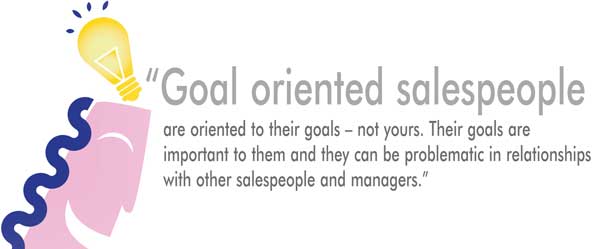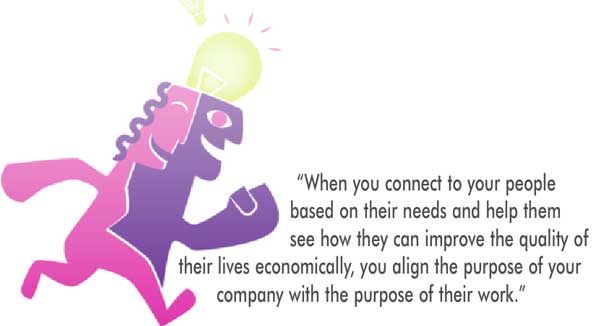Goals are the strategic management variable in my way of thinking. They are also probably the most abused, misunderstood, and/or ignored critical variable in retail store management. It’s due to the wrongly focused and completely top-down view most owners and managers have regarding goals.
My position is almost completely opposite that of many furniture store owners, and probably flies in the face of owners whose main attention is on the bottom line profits and long-term profitability of their companies. Of course there always is a “top line” focus on generating more sales revenue so you can improve your bottom line performance, but generally the things you do to improve your top line sales revenue cost money – whether more advertising expenditures, upgrading store looks, or locations, giving away more margin to sale pricing (I’m writing on Black Friday), all to attract more shoppers to your store versus all your competitors. Of course, as of this writing, your most dangerous competitor may not be the store down the street or across town, but the one right in your shoppers’ hands or homes – their internet connection.
In the November/December 2013 issue of Furniture World I promised to write about making a connection to your customer – to the person and the project. But, before looking at that topic let’s acknowledge that there is another connection that has to be made, and it’s just as important to successful retailers: It’s the one you and your managers (coaches) make with your people – your employees.
Connecting Furniture Salespeople with a Purpose
Our business – bricks & mortar furniture retailing depends almost entirely upon the one-to-one interpersonal skills of salespeople for generating revenue. Home furnishings retailers strive to provide a sufficient number of shoppers, so that enough sales will be closed to achieve the company’s revenue goals.
Advertising or a current promotion may attract shoppers to your store, but to achieve aggressive revenue goals, it is important that salespeople distinguish between what brings shoppers in the door, and that person’s underlying motivation for shopping. Only then can they make a meaningful connection between your customer and your store.

But before salespeople can effectively address shopper’s needs and motivations, managers (coaches) should work to establish a meaningful connection between your salespeople and your store’s stated objectives and mission. This is what completes the circuit, (store brand - salesperson - customer) to bring sales performance alive.
For many retail organizations though, company objectives and mission are not stated, so there is no higher purpose with which employees can connect. Making a profit is not a legitimate purpose because it is, in fact, the definition of a business.
So, what’s a shopper’s major underlying motivation? I take the view that what the lady wants is a beautiful, functional, comfortable home. She wants to feel good about what she buys, and be able to walk into every room in her home and think: “I love this room.”

So, maybe the stated purpose of your business could be “To furnish every room in every home in our market area to our customer’s joy and total satisfaction. We will offer the finest available quality furniture at many price levels, and provide advice and assistance, in order to satisfy the largest possible number of customers.”
Now, there’s something employees can “connect to” in terms of their personal needs to be involved in rewarding, satisfying work!
Making a connection to employees with a stated purpose like this is important. It’s equally important to provide training support and tools to help salespeople provide this stated level of service. Resources must also be applied to attract skilled people who want to work in this kind of environment, and focus company advertising, publicity, and social media messages to reflect this approach.
The Room as a Connecting Point
Most customers shop for one room at a time. Sure, there are exceptions and sometimes you’ll be lucky and get someone shopping for a whole home, although recently that’s less likely than it was 10 years ago. And many times they’ll be looking for one item for one room in the home – the one item that will make it right, or begin a process that can go on for months or even years.
When your salesperson meets your customer, the customer has knowledge the salesperson doesn’t have. She knows everything about her room. Your salesperson (or you) know nothing. So, the room is the connecting point for moving forward – always has been, always will be. Our business is far more than just showing things to people and explaining their features, then letting them select. Remember, there are no benefits to any product that lies outside a customer’s needs. It’s all about understanding the “picture in her mind” of the room now, and helping her use our products to form a new picture that she’ll buy.

Customer Buying Styles
That’s how you connect with customers in our business; you help them achieve their goals. However, there are two broadly defined customer buying styles: Transactional buyers tend not to appreciate or seek a lot of input from salespeople. They’re not rude, but tend to have things pretty well worked out. They need some technical information and to be sure that they are getting the best deal. If not, they’ll go elsewhere fast. Sometimes these people buy on the first visit to your store on a new furniture purchasing project. And, they’re the ones we all remember.
Then, there are the “relational” shoppers, who need much more hand-holding, guidance, and assurance that they’re making a good choice. And, they need to like and trust the salesperson (and the store). They may need multiple visits to make their decision, but will be loyal to a salesperson they like and trust.
Connecting with Home Furnishings Salesperson’s Needs
Do you really know your employees’ needs or, their individual attitudes toward goals? The literature on the subject of goal setting indicates that there are two fundamental types of personality traits regarding the issue of goals. There are goal oriented people, and task oriented people, and knowing the individual can make a huge difference to your company and your employees.
Goal oriented salespeople are oriented to their goals – not yours. Their goals are important to them and they can be problematic in relationships with other salespeople and managers. They are top producers and will do anything to achieve their goals – which usually are higher than those you would set for them, so they tend to do things that are – well, out-of-bounds.
For the task oriented people who just want to do the work of “waiting on customers”, goals are seen only as quotas and many can’t measure up – because they don’t know how, and have never in their lives set a goal for themselves. They do their work, as they define it for themselves, and what happens, happens. These folks are usually not affected by employment ads that speak to “$55,000 to $80,000 Annual Earnings.”
Both personality styles have other, personal, emotional, and financial needs. People need to feel they are involved in meaningful, satisfying work that provides them with an opportunity to belong to something “bigger” than themselves and to contribute – if only they understand what they’re contributing to. Task oriented people, who are usually not goal oriented, need help developing financial goals. That’s because they don’t believe they can achieve more than they already are achieving. These are the “I’m doing the best I can” people, and they are right.
When you connect to your people based on their needs and help them see how they can improve the quality of their lives economically (you have to actually know a lot about them to do this well), you align the purpose of your company with the purpose of their work. Show them that the way to improve their lives is, of course, by helping the company achieve its needs for growth and revenue to support its commitment to serve people in your community (the higher level purpose of your company).
In so doing, you stand a better chance of training them to change their selling behaviors. You may also change how they view their contribution to the process of satisfying customers.
Connecting Your Salespeople With Ideas
In addition to making this connection, you also need to help them apply new ideas to advance their selling strategy, provide them with constant feedback on their individual progress and about the progress of your company. Only then will you find that the achievement of your goals will be easier and your company will be a more satisfying place for everyone. A fully aligned company is a great place to work, to shop, and to own.
So, taking the time to connect to your employees in this way may lead to a better connection to your customers . Done well, everyone wins including your customers.
Joe Capillo is a 41 year career veteran, experienced in managing and consulting with furniture retail operations. He is also a contributing editor for Furniture World Magazine. He is a contributing editor to FURNITURE WORLD and a frequent speaker at industry functions. See all of Joe’s articles on the furninfo.com website.